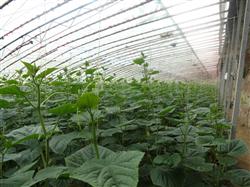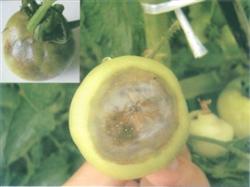Cultivation techniques of Pumpkin in greenhouse in Spring

I. Variety selection
Beijing green chestnut, Beijing red chestnut pumpkin.
2. Raising seedlings
The suitable sowing time for pumpkin cultivation in spring greenhouse is generally mid-February.
1. Preparation before raising seedlings
The temperature was low when sowing in the first and middle of February, so the electric hotbed must be used to raise seedlings.
The main results are as follows: (1) the production of electric hotbed: choose the greenhouse with good light transmittance and strong thermal insulation as the seedling greenhouse, and make the seedling bed 22.5 meters long, 1.5 meters wide and 15 centimeters deep in the greenhouse. After the bottom surface is flat and firm, 2 heating wires with a power of 1000 watts are used, 12 lines are arranged longitudinally at the bottom of the bed, the distance between the lines is 8: 10 cm, and the ground heating line is completely covered with fine soil with a depth of 1.5-2 cm.
(2) nutrient soil: use 6 parts of vegetable garden soil (no Cucurbitaceae crops), add 3 parts of completely rotten organic fertilizer and 1 part of peat, mix well, sieve, put into 10 cm × 10 cm nutrition bowl, arrange neatly in the electric hotbed and set aside.
(3) seed treatment: first, the selected seeds were exposed to the sun for 2 days, which could obviously promote the germination. Soak the full seeds in 50 ℃ warm water for 15 minutes while pouring water and stirring with an alcohol thermometer to keep the water temperature at 50 ℃ for 15 minutes; then keep stirring to reduce the water temperature to 30 ℃, soak the seeds for 3 to 4 hours, rub off the mucus from the seed surface, wash and remove, put it in a germination container and cover with a hygroscopic cloth.
(4) accelerating germination: wrap the sterilized seeds with wet cotton gauze and put them in a 28-30-℃ incubator and wash the seeds once a day in the morning and evening. The seeds can be sown when the seeds are exposed to the tip after 36 hours.
2. Sowing seeds
Sow the nutrition bowl thoroughly with water one day before sowing, and set up a hotline to keep the seedbed at a certain ground temperature. Use your hands to press a small hole about 2 cm deep in the nutrition bowl and spread poisonous soil (9 grams of 25% metalaxyl wettable powder plus 70% mancozeb wettable powder to 1 gram of fine soil, mix well and pile up for 24 hours). Put the germinated seeds in a small hole in the nutrition bowl and cover the hole with fine soil, then spread poisonous soil and cover the plastic film on the small arch shed.
3. Seedling stage management
The main results are as follows: (1) the temperature management should follow the principle of high before emergence and appropriate decrease after emergence. The specific management requirements are shown in Table 4.
┌─┬─┬───┬───┐
│ growing period │ soil temperature │ air temperature │ soil temperature │ air temperature │
│ │ (℃) │
├─┼─── ┼───┼───┼─ ─┤
│ sowing ~ full seedling │ 2530 │ 28 │ 25 2025 │
├─┼───┤
│ seedlings ~ 15 days before planting 20: 24 │ 22: 25 │ 20 │ 15: 18 │
├─┼───┤
15 days before │ planting, refining seedlings above │ 15, │ 22, 24 │ 12, │ 15 and above │.
├─┼───┤
│ seedlings (5 days before planting) │ 10 or above │ 22 │ 8 or │ 15 │
└─┴───┘
(2) Water management: the focus of pre-emergence management is heat preservation and moisturizing, in order to speed up seedling emergence. The seedling stage is generally not watered, but when the soil hair in the nutrition bowl is found to be dry, spray about 25 ℃ of warm water in time, not too much, to prevent rotten seeds, when more than 50% of the seedlings are unearthed, plastic sheeting should be opened to prevent overgrowth. Adequate light should be ensured at cotyledon stage and seedling stage, and the daytime temperature should be controlled at 20 ℃ ~ 25 ℃ and night temperature should be controlled at 15 ℃ ~ 18 ℃. The ground temperature is between 20 ℃ and 23 ℃. In order to increase the occurrence of lateral root group and cultivate strong seedlings, the seedlings should be inverted in time and poured through the bottom water. The standard of strong seedling: plant height 21cm 23cm, stem diameter 1cm, true leaf 4cm, petiole and stem at an angle of 45 degrees, seedling age 2530 days.
III. Colonization
1. Soil preparation and fertilization
In order to create a soil environment rich in organic matter, loose and good permeability, attention should be paid to the application of high-quality organic fertilizer. 10-15 days before planting, 6000kg / mu of rotten high-quality ring fertilizer, 500kg / mu of rotten chicken manure and 40kg / mu of calcium superphosphate should be applied and raked flat after fertilization. In order to increase the temperature in the greenhouse, the film should be fastened 15 days before planting.
- Prev

Intercropping cultivation techniques of cauliflower and pumpkin in spring
When it comes to hanging vines in the arch shed pumpkin in spring, many vegetable farmers will choose one-word hanging vines. One-word hanging vines only need to lift the two vines of the pumpkin side by side, so that the hanging vines are faster. However, due to the large leaves of pumpkin, it appears to be very crowded at the beginning, which is not conducive to pumpkin coloring. Jitai Town, Shouguang City, Shandong Province.
- Next

Efficient intercropping techniques of spring cauliflower and pumpkin
First, symptoms: 1, seedlings: the disease appears dark green water-immersed disease spot, from the leaf to the main stem, so that the petiole and stem become thin and black-brown and rotten, the whole plant wilts, and the disease produces a white mold layer when the humidity is high. The disease occurs at the base of the young stem, forming waterlogged constriction, and the seedlings wilt or lodge. 2 、...
Related
- Where is it suitable to grow horseradish in China? it is expected to see the middle altitude horseradish in Alishan.
- How to prevent tomato virus disease reasonably? (Control methods included)
- Many people like to plant towel gourd on the balcony. What are the main points of this method and management?
- What crops can chili peppers be mixed with?
- Fertilization techniques and matters needing attention in Tomato
- What are the grafting techniques for peach seedlings in spring?
- Harm and control methods of root swelling disease of Chinese cabbage
- What are the pests of sweet potatoes? How to prevent and cure it?
- Symptoms, causes and Control methods of navel Rot in Tomato
- The cause of "Cucumber rotten bibcock" in Farmers' planting Cucumber and its Control Plan

